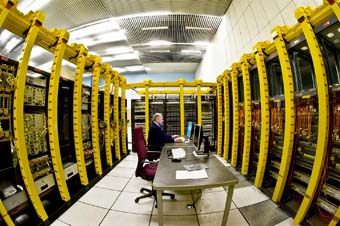
What does the Higgs boson has to do with ‘cloud’ computing? And the discovery of the W and Z bosons with the creation of the World Wide Web (WWW), the language we use every day when we access the Internet? The relationship between particle physics research and developments in computer and computing science is the subject of the conference which Manuel Delfino, Director of Scientific Information Port (CIP) offers on Tuesday 11 March at the Cultural Centre of La Nau of the University of Valencia (c/ Universitat, 2), from 19:00 and free admission while space is available.
The PIC is the only computing centre located in Spain of the eleven which constitute the primary network which stores and processes data from the Large Hadron Collider (LHC). The conference will take place in the Aula Magna of historic seat of the University and it can be followed live on MediaUni (http://mediauni.uv.es/tv).
Delfino will explain how to manage the enormous volume of data of LHC, equivalent to 700 years of high-definition movies in their first three years of operation (2010-2013). To do so, they had to create a system able to distribute, store and process that information, ‘photos’ with details of particle collisions that occur inside. This system, called Grid, is a distributed computing network with 160 centres in 35 countries.
Spain contributes 4% of network computing resources for LHC. In addition to the PIC directed by Delfino, several scientific institutions (including IFIC) collaborate in other seven centres of second level (Tier 2). This technology, which allowed the discovery of the famous Higgs boson, also allows the ‘cloud’ computing, increasingly used commercially, and the development of social networks.
This is the idea of the conference: show how of the needs arisen in the pursuit of the basic components of matter, were born in technologies that have revolutionised computer and computing science. The clearest example is the origin of the World Wide Web (WWW), the language on which the Internet was invented at the European Laboratory for Particle Physics (CERN) by Tim Berners-Lee in the early nineties. This technology made available to the company and free of charge, was created to provide to the physics of the era access to the information, which allowed the discovery of the W and Z bosons (carriers of the fundamental forces of nature).
Manuel Delfino (Caracas, 1956) is full university professor of Physics at the <i>Universitat Autònoma de Barcelona</i>. Since 2003 he directs the PIC in Barcelona, a consortium between the Institute of High Energy Physics (IFAE) and CIEMAT. From 1999 to 2002 he was director of Information Technologies at CERN, where he launched the R+D programme to solve the problem of the data management of LHC. Between 1995 and 1998 he led the project of CERN which developed the technological basis of the “farms” of tens of thousands of computers which store and process data from experiments of current particle physics. The advisory committee of computering is presided by the European Laboratory of Gravitational Waves (EGO).
The conference is part of the cycle “Enigmas of the matter and the Universe: science, technology and society”, organised by the Institute of Corpuscular Physics (IFIC, CSIC- UV) in collaboration with the Office of the Vice‐Principal for Culture and Equality of the University of Valencia due to the celebration on July of the main conference on particle physics, ICHEP2014.
More information:
http://ichep2014.es/content/ciclo-conferencias-public-seminars
Last update: 11 de march de 2014 08:00.
News release



















